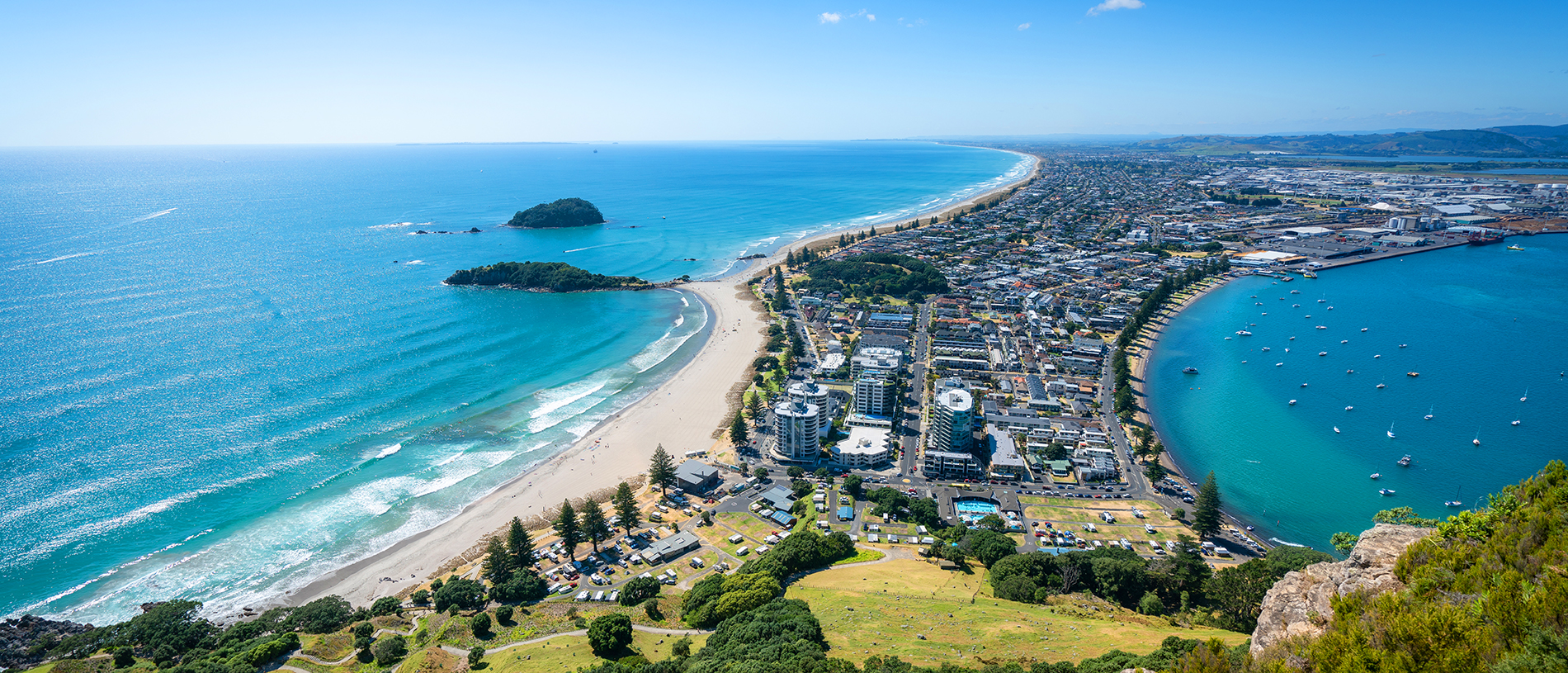
Discover the highlights of the Bay of Plenty
From gin to avocados, hot pools, short walks and a Sea Lion - we get a taste of the Bay of Plenty.
Jump off a wharf, make a ‘V’ with your body, displace as much water as possible.
To ‘pop a manu’ is a classic Kiwi summer pastime that’s been turned into an annual competition – the Z Manu World Championships at Auckland’s Viaduct Harbour – by former national swimming champion, Scott Rice.
Scott, tell us about your background?
I was a competitive swimmer from the age of 10 until I was 23. I took it pretty seriously and made it onto a New Zealand team. Swimming is quite solitary. Generally, your face is in the water and you're swimming laps, so what you're putting in is what you get out. What I took from it is that no one else is going to do it for you. That drive transferred into business, to wanting to be entrepreneurial and create events and new brands. My career is fun, sometimes challenging and I'm proud of what I've created over the last 20 years.

Where did the idea for the Z Manu World Championships come from?
As a kid, I was always around water and I remember doing ‘dive bombs’. It was part of Kiwi summer. I was a pool lifeguard when I was a teenager and there were guys who would get dropped off in the morning and they'd just do bombs for five hours straight. I thought ‘I reckon we should create an event for it’.
How did last year’s event go?
The first year is always the hardest. You're running a bit blind and using your experience from the past to crystal ball-gaze for what may happen. Then it's about refining the event to ensure it’s relevant to the people you want to attract, a good experience for those attending and also that you’re delivering value for sponsors and partners.
So, was it easy to get sponsors on board with the idea?
Of all the events I've ever run, this one just put smiles on faces from the get-go. It was the easiest sell I've ever had. I think because it's just a fun concept. It's about creating the biggest splash. It's just positive. It's uniquely Kiwi and also it attracts youth, which is an audience brands want to be engaging with because they're potential future customers.

Was it just as easy to attract entrants?
Now, that was interesting. I thought we were just going to launch it and the entire bombing community would be lining up in droves. What I discovered is that the audience of predominantly Māori and Pacific People are quite humble, so putting themselves out there in front of a crowd to be the best took some encouragement.
What are the biggest lessons you took from the first event?
Registrations at the beginning were a lot slower than we thought and alarm bells started to ring. In the end we just pushed hard, and we ended up filling all the spots we had in the week before the event. In some cases the last few spots filled on the day. One of the big learnings from the first year is that not everyone doing bombs wants to be in a competition to win something and that's OK.

And Water Safety New Zealand got on board as well?
Running an event just to find the person who makes the biggest splash is fun but there needs to be a social benefit as well. We want to give back, I guess, or work with communities to help get youth active and stay safe around the water. Our key purposes were about celebrating the art of the manu, getting youth active in a non-traditional way, and water safety. The event also bought diverse communities together, with various ethnicities, ages and genders. There was an eclectic mix of people in the audience, everyone enjoying the same thing, and that was really cool.
Are you making any changes to the event this year?
We’re expanding the event. Last year, we ran qualifying events in Wellington, Christchurch, Hamilton and Auckland, and this year we’ve partnered with other bombing competitions to make them official qualifying events. We've gone from four cities to eight with Tauranga, Hastings, Nelson, Māngere and Whangārei. Last year, we gave away $30,000 in cash and prizes and this year the prize pool is worth $40,000.

What did the grand final entail?
The infrastructure was bigger than we've ever done before. It needed to be grand and it absolutely paid off because people walked past and they went, ‘wow’. The scaffolding tower really did look amazing. I felt if we wanted to be up there with the likes of the Red Bull Cliff diving, we needed to build a tower.
That was probably one of the most special things for me in my whole career, to be honest; walking into the Viaduct to see that 19-metre wide, seven-metre-high platform in real life. It was even better than we expected.
The Viaduct was such a brilliant location. The crowd at the grand final was huge – probably between 30,000 and 40,000 people watching or walking through the event.
Will it become a genuine world championship?
We’ve had some good discussions with the Gold Coast events team. There’s also a guy in Hawaii running an event that’s similar, but right now we're concentrating on making this New Zealand event fantastic.
This story is from the Summer 2024 issue of AA Directions Magazine.